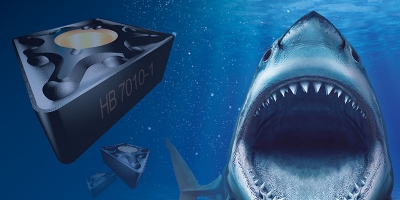
The Hoffman Group offers a turning grade for machining steel. The GARANT HB 7010-1 turning grade was developed to achieve wear resistance at the highest cutting speeds, according to the company. For this purpose, the Hoffmann Group has reconstructed the innovative coating of the GARANT HB 7020 that was introduced in summer 2015 so that it now features a P10 gradient carbide that is optimized for continuous high-performance cutting. The GARANT HB 7010-1 is therefore a suitable tool material for continuous cutting, while the GARANT HB 7020 is suitable for lightly interrupted cutting and difficult operating conditions.
A shark's tooth was the inspiration for the Hoffmann Group when developing the GARANT HB70xx product family: a hard and extremely smooth exterior and a ductile interior. The GARANT HB 7010-1 has an extremely hard, wear-resistant and thermo-resistant CVD coating made of aluminum oxide (Al203) and titanium carbonitride Ti(C,N), which protects the carbide substrate, even at high cutting speeds and process temperatures. The carbide substrate is particularly resistant to plastic deformation, splintering and brittle fracturing as it is extremely ductile. This turning grade therefore reaches a significantly long tool life with continuous cutting and at high cutting speeds.
The coating is particularly resistant thanks to straightened crystal structures. It’s extremely smooth surface enables optimal chip evacuation via the insert surface and reduces the friction between the component and the tool material. This lowers the process temperatures.
In contrast to the casing, the core of the indexable insert is ductile. The carbide substrate is graded, which means that it has an increased proportion of titanium nitride (TiN) in the outer layer in order to adapt the thermal expansion coefficient to the coating. As a result, the coating optimally adheres to the substrate and because of the similar thermal expansion coefficient, the coating cannot shear away, even at high process temperatures.
Contact Details
Related Glossary Terms
- Brinell hardness number ( HB)
Brinell hardness number ( HB)
Number related to the applied load (usually, 500 kgf and 3,000 kgf) and to the surface area of the permanent impression made by a 10mm ball indenter. The Brinell hardness number is a calculated value of the applied load (kgf) divided by the surface area of the indentation (mm2). Therefore, the unit of measure of a Brinell hardness number is kgf/mm2, but it is always omitted.
- aluminum oxide
aluminum oxide
Aluminum oxide, also known as corundum, is used in grinding wheels. The chemical formula is Al2O3. Aluminum oxide is the base for ceramics, which are used in cutting tools for high-speed machining with light chip removal. Aluminum oxide is widely used as coating material applied to carbide substrates by chemical vapor deposition. Coated carbide inserts with Al2O3 layers withstand high cutting speeds, as well as abrasive and crater wear.
- chemical vapor deposition ( CVD)
chemical vapor deposition ( CVD)
High-temperature (1,000° C or higher), atmosphere-controlled process in which a chemical reaction is induced for the purpose of depositing a coating 2µm to 12µm thick on a tool’s surface. See coated tools; PVD, physical vapor deposition.
- indexable insert
indexable insert
Replaceable tool that clamps into a tool body, drill, mill or other cutter body designed to accommodate inserts. Most inserts are made of cemented carbide. Often they are coated with a hard material. Other insert materials are ceramic, cermet, polycrystalline cubic boron nitride and polycrystalline diamond. The insert is used until dull, then indexed, or turned, to expose a fresh cutting edge. When the entire insert is dull, it is usually discarded. Some inserts can be resharpened.
- plastic deformation
plastic deformation
Permanent (inelastic) distortion of metals under applied stresses that strain the material beyond its elastic limit.
- titanium carbonitride ( TiCN)
titanium carbonitride ( TiCN)
Often used as a tool coating. See coated tools.
- titanium nitride ( TiN)
titanium nitride ( TiN)
Added to titanium-carbide tooling to permit machining of hard metals at high speeds. Also used as a tool coating. See coated tools.
- turning
turning
Workpiece is held in a chuck, mounted on a face plate or secured between centers and rotated while a cutting tool, normally a single-point tool, is fed into it along its periphery or across its end or face. Takes the form of straight turning (cutting along the periphery of the workpiece); taper turning (creating a taper); step turning (turning different-size diameters on the same work); chamfering (beveling an edge or shoulder); facing (cutting on an end); turning threads (usually external but can be internal); roughing (high-volume metal removal); and finishing (final light cuts). Performed on lathes, turning centers, chucking machines, automatic screw machines and similar machines.
- wear resistance
wear resistance
Ability of the tool to withstand stresses that cause it to wear during cutting; an attribute linked to alloy composition, base material, thermal conditions, type of tooling and operation and other variables.






